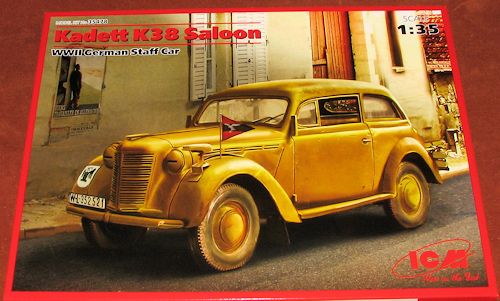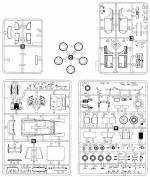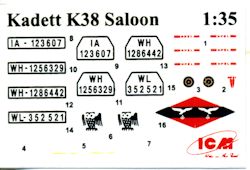
ICM 1/35 Kadett K38 Saloon
| KIT #: | 35478 |
| PRICE: | $37.95 SRP |
| DECALS: | Four options |
| REVIEWER: | Scott Van Aken |
| NOTES: | New tool kit |

| HISTORY |
The first Opel car to carry the Kadett name was presented to the public in December 1936 by Opel's Commercial-Technical director, Heinrich Nordhoff, who would in later decades become known for his leadership role in building up the Volkswagen company.
The new Kadett followed the innovative Opel Olympia in adopting a chassis-less monocoque construction, suggesting that like the Vauxhall 10 introduced in 1937 by Opel's English sister-company, the Opel Kadett was designed for high volume low cost production.
For 1937 the Kadett was offered as a small and unpretentious two door "Limousine" (sedan/saloon) or, at the same list price of 2,100 Marks, as a soft top "Cabrio-Limousine". The body resembled that of the existing larger Opel Olympia and its silhouette reflected the "streamlining" tendencies of the time. The 1,074cc side-valve engine came from the 1935 Opel P4 and came with the same listed maximum power output of 23 PS (17 kW; 23 hp) at 3,400 rpm.
The brakes were now controlled using a hydraulic mechanism. The suspension featured synchromous springing, a suspension configuration already seen on the manufacturer's larger models and based on the Dubonnet system for which General Motors in France had purchased the license. The General Motors version, which had been further developed by Opel’s North American parent, was intended to provide a soft ride, but there was some criticism that handling and road-holding were compromised, especially when the system was applied to small light-weight cars such as the Kadett. By the end of 1937 33,402 of these first generation Kadetts had been produced.
From December 1937 a modified front grill signalled an upgrade. However, the 1,074cc Opel 23 PS (17 kW; 23 hp) engine and the 2,337 mm (92.0 in) wheelbase were unchanged, and it would have taken a keen eyed observer to spot the difference between the cars for 1937 and those for 1938.
The manufacturer now offered two versions of the Kadett, designated the "Kadett KJ38 and the "Kadett K38" the latter also being sold as the "Kadett Spezial". Mechanically and in terms of published performance there was little to differentiate the two, but the "Spezial" had a chrome stripe below the window line, and extra external body trim in other areas such as on the front grill. The interior of the "Spezial" was also better equipped. To the extent that the 300 Mark saving for buyers of the car reflected reduced production costs, the major difference was that the more basic "KJ38" lost the synchromous springing with which the car had been launched, and which continued to be fitted on the "Spezial". The base car instead reverted to traditional rigid axle based suspension similar to that fitted on the old Opel P4.
The base car was available only as a two door "Limousine" (sedan/saloon). Customers looking for a soft-top "Cabrio-limousine would need to specify a "Kadett Spezial". For the first time Kadett buyers, provided they were prepared to choose a "Kadett Spezial" could also specify a four-door "Limousine" (sedan/saloon) bodied car, priced at 2,350 Marks as against 2,150 Marks for a "Spezial Cabrio-Limousine" and 2,100 Marks for a two-door "Spezial Limousine"
In marketing terms the "Kadett KJ38" was intended to fill the niche that Opel had recently vacated with the departure of the Opel P4, but the KJ38, priced at 1,800 Marks, was more expensive than the P4 and its reduced specification left it with the image of a car for poor people at a time when economic growth in Germany was finally fostering a less minimalist approach to car buying. The "Kadett K38 Spezial" fared better in the market place: in 1938 and again in 1939 it was Germany's the top selling small car. By May 1941 the company had produced 17,871 "Kadett KJ38"s and 56,335 "Kadett K38 Spezial"s.
Competitive pricing led to commercial success, and Kadetts continued to be produced during the early months of the war: by the time production ended in May 1940, following intensification of World War II, 106,608 of these Opel Kadetts had come off the assembly line at Opel's Rüsselsheim plant, which had been the first major car plant in Germany to apply the assembly-line production techniques pioneered by Henry Ford.
After the war, Opel production facilities from Brandenburg an der Havel (trucks) were crated up together with the production line plant and tooling from the Ruesslesheim (cars) plant and transported to the Soviet Union, along with the drawings and plans for the Kadett, as part of a larger reparations package agreed upon by the victorious powers. From 1948, the prewar Kadett was manufactured as the Moskvitch 400/420 and continued to be produced, very little changed, on the edge of Moscow until 1956.
| THE KIT |
 ICM is continuing to produce kits of staff cars of all sizes with this one being one of the smaller vehicles that were used. From what I gather, this car was used more in civilian use than the military, but apparently many were produced for staff use once the war got under way.
ICM is continuing to produce kits of staff cars of all sizes with this one being one of the smaller vehicles that were used. From what I gather, this car was used more in civilian use than the military, but apparently many were produced for staff use once the war got under way.  Instructions are nicely done and provide generic paint information where required. They also show optional bits and pieced depending on which of the four paint version you are doing. These basically differ by color and license plates. One is a civil type in a dark blue, one in France during 1940 in black-grey, one in Russia in 1942 in white and one in France in 1944 in Panzer DarkYellow. The decal sheet provides the license plates and instruments and other markings.
Instructions are nicely done and provide generic paint information where required. They also show optional bits and pieced depending on which of the four paint version you are doing. These basically differ by color and license plates. One is a civil type in a dark blue, one in France during 1940 in black-grey, one in Russia in 1942 in white and one in France in 1944 in Panzer DarkYellow. The decal sheet provides the license plates and instruments and other markings. | CONCLUSIONS |
| REFERENCES |
http://en.wikipedia.org/wiki/Opel_Kadett
June 2013
My thanks to Squadron Products for the preview kit. This one is available now at your favorite retailer.
If you would like your product reviewed fairly and fairly quickly, please contact the editor or see other details in the
Back to the Previews Index Page